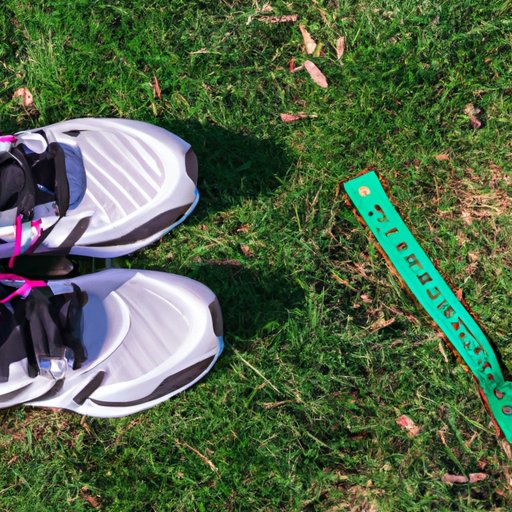
Introduction
It’s no secret that regular exercise is critical for maintaining a healthy weight, but when it comes to choosing between running and walking, things can get confusing. Both activities have their benefits, but figuring out which is best for weight loss can be a challenge. In this article, we will explore the science behind walking and running, debunk common myths, and provide practical advice for deciding which activity is right for you.
The Science Behind Walking and Running: Which is Better for Weight Loss?
When it comes to burning calories and shedding excess pounds, walking and running are both effective options. During exercise, the body burns calories to provide energy for muscle movement. By creating a calorie deficit through exercise, individuals can lose weight over time.
However, the amount of energy expended during walking and running varies significantly. While running burns more calories per minute, in terms of energy expenditure, walking for a longer duration can be just as effective.
Research has shown that for the same amount of energy expenditure, fast walking can lead to greater weight loss than slow running. Additionally, walking can be an ideal starting point for individuals who are new to exercise or have physical limitations.
The Ultimate Guide to Choosing Between Running and Walking for Weight Loss
Deciding whether to walk or run for weight loss depends on several factors. Age, fitness level, and time constraints are some of the most significant factors to consider. Other considerations include personal preferences, health history, and injury prevention.
Before starting any exercise program, it’s always best to consult with a healthcare provider. They can provide guidance on the types of activities that are appropriate based on individual health status and physical capabilities.
When deciding whether to walk or run for weight loss, it’s essential to set realistic goals and have patience. Weight loss doesn’t happen overnight, and it’s important to take a gradual approach.
Myth vs. Reality: Debunking the Pros and Cons of Walking and Running for Weight Loss
There are many misconceptions about walking and running for weight loss. One of the most prevalent myths is that running is always better for weight loss than walking. However, the truth is that walking can be just as effective, especially for individuals who aren’t ready for the high-impact nature of running.
Another myth is that running is bad for the knees. While it’s true that running can put more stress on the knees than walking, there is no evidence to suggest that running leads to long-term joint damage. However, it’s essential to take precautions such as wearing proper footwear and avoiding running on hard surfaces to minimize the risk of injury.
The Beginner’s Weight Loss Guide: Starting with Walking or Running?
For individuals who are new to exercise and weight loss, starting with walking is an excellent option. Walking provides low-impact aerobic activity that can improve cardiovascular endurance and burn calories.
Before starting to walk or run, it’s important to ensure that proper stretching and warm-up routines are in place. This can help reduce the risk of injury and improve overall workout effectiveness.
When starting an exercise program, it’s also important to begin slowly and gradually increase intensity over time. This helps avoid burnout and injury.
Injury Prevention: Determining Which is Better – Running or Walking – to Avoid Physical Damage and Achieve Weight Loss
Injury prevention is a critical aspect of any exercise program. When it comes to running and walking, the risk of injury can be minimized through proper form, footwear, and gradual increases in distance and intensity.
Individuals who are new to exercise or have physical limitations may prefer walking as a low-impact alternative to running. However, running can be an excellent option for individuals looking to burn more calories in a shorter amount of time.
Incorporating strength training into a running or walking routine can also help prevent injury. Strengthening the muscles in the legs, core, and upper body can improve overall physical health and reduce the risk of injury.
The Optimal Way to Use Running or Walking for Weight Loss? Comparing Routines and Duration
Different types of running or walking routines can be used to optimize weight loss. In general, longer durations of exercise lead to more calories burned. However, incorporating interval training can also lead to weight loss benefits.
Interval training involves alternating bursts of high-intensity exercise with periods of rest or lower-intensity exercise. This can help boost metabolism and increase the number of calories burned over time.
Individuals looking for a challenge may prefer high-intensity interval training, which involves shorter periods of maximum effort followed by periods of rest. This type of training can improve cardiovascular endurance, burn calories, and support weight loss.
Going Outside the Box: Combining Running and Walking to Boost Motivation and Increase Weight Loss
Combining running and walking can be an excellent way to boost motivation and increase weight loss. By alternating between the two activities, individuals can challenge their bodies and prevent burnout.
Cross-training activities, such as cycling or swimming, can also be incorporated into an exercise program to provide variety and support weight loss. It’s important to create a routine that is both challenging and enjoyable to maintain long-term motivation.
Conclusion
Choosing between running and walking for weight loss depends on individual preferences and physical capabilities. Both activities can provide significant health benefits, including burning calories, improving cardiovascular health, and reducing the risk of chronic disease. By following practical advice and incorporating injury prevention tips, individuals can create a workout routine that supports weight loss and overall physical health goals.
If you’re interested in learning more about weight loss and fitness, consult with a healthcare provider or a certified personal trainer. They can provide support, advice, and guidance on creating a personalized exercise program that meets your specific needs and goals.




